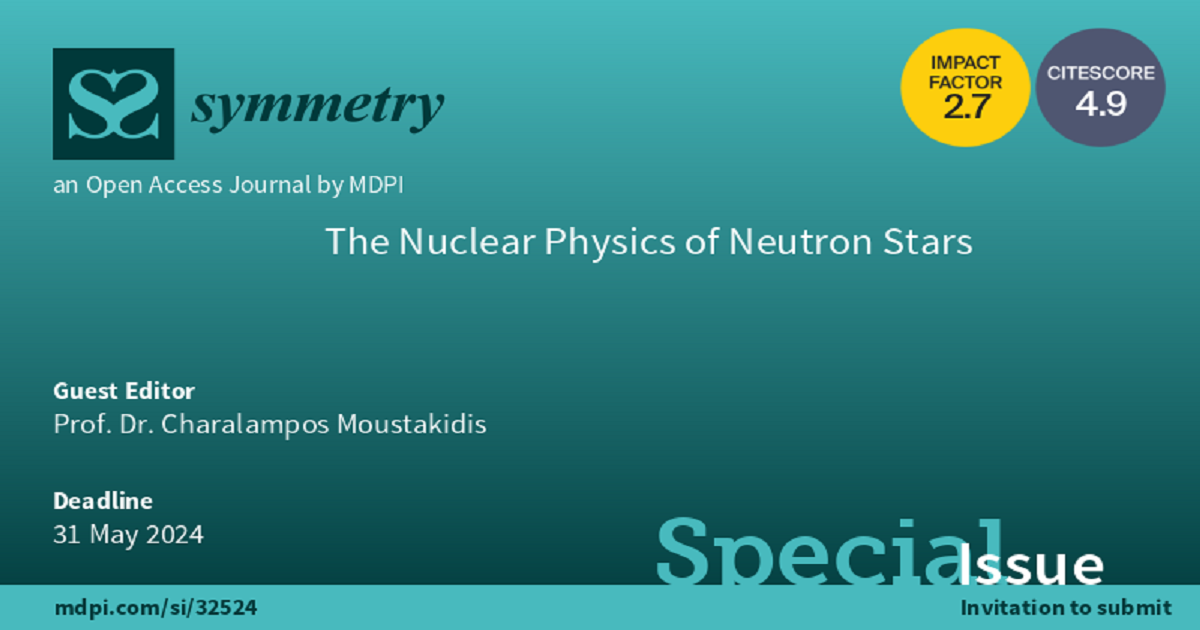- 2.2Impact Factor
- 5.3CiteScore
- 18 daysTime to First Decision
The Nuclear Physics of Neutron Stars
This special issue belongs to the section “Physics“.
Special Issue Information
Dear Colleagues,
Neutron stars are considered extraordinary astronomical laboratories for the physics of nuclear matter as they have the most fascinating constitution of energy and matter in the Universe. Recently, the detection of gravitational waves from the merger of two neutron stars, in a binary neutron-star system, opened a new window to explore the physics of neutron stars. In particular, the majority of the static, as well as the dynamical processes of neutron stars, are sensitively dependent on the employed equation of state. However, the knowledge of the equation of state, especially at high densities, is very uncertain and, therefore, the relevant predictions and estimations are suffering.
One of the long-standing subjects in astrophysics is the determination of the maximum mass of a neutron star (non-rotating and rotating). Neutron stars are directly related to the formation of black holes (Kerr black holes), connecting two of the most important astrophysical objects. As a consequence, the maximum neutron star mass is of great interest in studying the effect of both neutron stars and black holes on the dynamics of supernovae explosion.
Furthermore, neutron stars, due to their compactness, may rotate very fast compared to other astrophysical objects. In particular, measurement of specific properties of rapidly rotating neutron stars (including the mass and radius, frequency, moment of inertia, quadrupole moment, etc.) may lead to robust constraints on the equation of state, as well as on the constitute of nuclear matter at very high densities.
The propose of this Special Issue is to collect contributions exploring modern applications of the theory of nuclear matter in neutron stars, as well as proposed ideas to constrain the equation of state both of cold and hot nuclear matter (low/high densities) with the help of recent observations including mainly observational data form radio-pulsars, X-rays sources, gamma-ray burst sources, etc. as well as the detection of gravitational waves originating from neutron stars mergers. We wish to invite both original and review papers to this Special Issue along the lines mentioned above.
Prof. Dr. Charalampos Moustakidis
Guest Editor
Manuscript Submission Information
Manuscripts should be submitted online at www.mdpi.com by registering and logging in to this website. Once you are registered, click here to go to the submission form. Manuscripts can be submitted until the deadline. All submissions that pass pre-check are peer-reviewed. Accepted papers will be published continuously in the journal (as soon as accepted) and will be listed together on the special issue website. Research articles, review articles as well as short communications are invited. For planned papers, a title and short abstract (about 250 words) can be sent to the Editorial Office for assessment.
Submitted manuscripts should not have been published previously, nor be under consideration for publication elsewhere (except conference proceedings papers). All manuscripts are thoroughly refereed through a single-blind peer-review process. A guide for authors and other relevant information for submission of manuscripts is available on the Instructions for Authors page. Symmetry is an international peer-reviewed open access monthly journal published by MDPI.
Please visit the Instructions for Authors page before submitting a manuscript. The Article Processing Charge (APC) for publication in this open access journal is 2400 CHF (Swiss Francs). Submitted papers should be well formatted and use good English. Authors may use MDPI's English editing service prior to publication or during author revisions.
Keywords
- neutron stars
- equation of state of nuclear matter
- gravitational waves
- cold and hot nuclear matter
- binary neutron star systems
- pulsars

Benefits of Publishing in a Special Issue
- Ease of navigation: Grouping papers by topic helps scholars navigate broad scope journals more efficiently.
- Greater discoverability: Special Issues support the reach and impact of scientific research. Articles in Special Issues are more discoverable and cited more frequently.
- Expansion of research network: Special Issues facilitate connections among authors, fostering scientific collaborations.
- External promotion: Articles in Special Issues are often promoted through the journal's social media, increasing their visibility.
- e-Book format: Special Issues with more than 10 articles can be published as dedicated e-books, ensuring wide and rapid dissemination.

